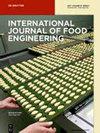Enzyme activities and volatile flavor compound compositions of tiger nut paste prepared using different fungal starter strains
IF 1.6
4区 农林科学
引用次数: 0
Abstract
In order to clarify effects of different fungal strains on fermented tiger nut paste enzyme activities and volatile flavor compounds composition, koji enzyme activities and volatile flavor substances of six tiger nut paste preparations (S1–S6) were compared. The results revealed that koji enzyme activities of S4, S5 and S6 were significantly higher than corresponding activities of S1, S2 and S3. Among them, S4 exhibited the highest enzyme activity levels for cellulase, xylanase, acid protease, glucosidase, and amylase. GC-MS analysis of the six paste preparations detected 43 volatile components, including 17 aldehydes, 8 alkenes, 4 heterocyclics, 2 ketones, 2 phenols and 7 other types of compounds. Notably, S4 had the most volatile compounds (28), including 5 volatile compounds which were not detected in the other tiger nut pastes. Results of principal component analysis and partial least squares discriminant analysis (PLS-DA) revealed differences in levels of 17 volatile flavor substances among the six tiger nut paste preparations. Notably, PLS-DA results achieved more significant separation and stronger clustering trends when used to discriminate among volatile flavor substances of paste preparations fermented using single-strain starters (S1, S2, S3) versus double-strain starters (S4, S5, S6) consisting of Aspergillus oryzae, Aspergillus niger and/or Mucor. The tiger nut paste (S4) prepared by mixed fermentation of A. oryzae and A. niger had a unique flavor, producing the highest enzyme activity and a wider variety of volatile flavor compounds. Therefore, the production of tiger nut paste through compound strain koji fermentation was a feasible strategy.使用不同真菌起始菌株制备的虎皮果酱的酶活性和挥发性风味化合物成分
为了弄清不同真菌菌株对发酵虎皮果酱酶活性和挥发性风味化合物组成的影响,比较了六种虎皮果酱制剂(S1-S6)的麴酶活性和挥发性风味物质。结果表明,S4、S5 和 S6 的麴酶活性明显高于 S1、S2 和 S3。其中,S4 的纤维素酶、木聚糖酶、酸性蛋白酶、葡萄糖苷酶和淀粉酶的酶活水平最高。对六种糊剂进行的气相色谱-质谱分析检测出 43 种挥发性成分,包括 17 种醛、8 种烯、4 种杂环、2 种酮、2 种酚和 7 种其他化合物。值得注意的是,S4 中的挥发性化合物最多(28 种),其中有 5 种挥发性化合物在其他虎果酱中均未检测到。主成分分析和偏最小二乘判别分析(PLS-DA)的结果显示,六种虎皮果酱中 17 种挥发性风味物质的含量存在差异。值得注意的是,在区分使用单菌株发酵剂(S1、S2、S3)和由黑曲霉、黑曲霉和/或粘菌组成的双菌株发酵剂(S4、S5、S6)发酵的糊状物的挥发性风味物质时,PLS-DA 的结果具有更显著的分离性和更强的聚类趋势。通过奥氏曲霉和黑曲霉混合发酵制备的虎皮果酱(S4)风味独特,产生的酶活性最高,挥发性风味化合物种类也更多。因此,通过复合菌株麴发酵生产虎坚果糊是一种可行的策略。
本文章由计算机程序翻译,如有差异,请以英文原文为准。
求助全文
约1分钟内获得全文
求助全文
来源期刊
CiteScore
3.20
自引率
0.00%
发文量
52
审稿时长
3.8 months
期刊介绍:
International Journal of Food Engineering is devoted to engineering disciplines related to processing foods. The areas of interest include heat, mass transfer and fluid flow in food processing; food microstructure development and characterization; application of artificial intelligence in food engineering research and in industry; food biotechnology; and mathematical modeling and software development for food processing purposes. Authors and editors come from top engineering programs around the world: the U.S., Canada, the U.K., and Western Europe, but also South America, Asia, Africa, and the Middle East.

 求助内容:
求助内容: 应助结果提醒方式:
应助结果提醒方式:


